- Illumination Analysis & Optical Design Software
- TracePro – Illumination & Optical/Opto-Mechanical Design Software
Features | Applications | RayViz for SolidWorks - OSLO – Optical Design Software
Feature Highlights - VirtualLab - Ray, Wave & Electromagnetic Optic Design Software
Software | Solutions | Services - Lighting Design Software & Services

VirtualLab Fusion - Unified Optical Design
Services
VirtualLab Support and Consulting
We offer you VirtualLab support and consulting services in optical engineering on an hourly basis. Our support packages include:
- Technical consulting for simulation and design of optical systems
- Online meetings and online help on optical system setups in VirtualLab
- Short online training on VirtualLab
- Programming and modification of customized snippets and VirtualLab modules
- Assistance during setup, simulation and optimization of optical systems
Optical Engineering
VirtualLab provides you with a powerful toolbox to solve your optical engineering tasks. The latest research in optical engineering is considered and implemented in VirtualLab for your use. However, you may be interested to outsource your optical engineering problem to world leading experts in the areas of diffractive optics, micro-optics, and all types of wave-optical simulation of optical systems. In that case the team at LightTrans is ready to solve your optical engineering problem.
In a typical optical engineering scenario a couple of free consulting meetings take place before LightTrans suggests you a procedure to solve the optical engineering task of concern. If you wish to perform most of the work yourself, VirtualLab can be customized to answer your specific needs. Accompanied by training which LightTrans team members are going to give this package enables you to handle your engineering task. In other cases it can be wise to do the first steps in the engineering project together with LightTrans team members in a joint engineering project. Finally, numerous customers ask LightTrans to undertake the complete engineering work. In case your problem requires the development of a new technology, LightTrans is often willing to run the risk and to provide you with a license of our solution. Independently of your specific choice, we will enable you to solve your engineering task as part of your innovation network.
LightTrans offers optical engineering services in diffractive optics, micro-optics, and all types of wave-optical simulations of optical systems. This includes modeling and design of systems for:
- Image Formation
- Focusing and Collimation
- Beam Shaping
- Beam Splitter
- Light Diffusing
- Head-up Display Application
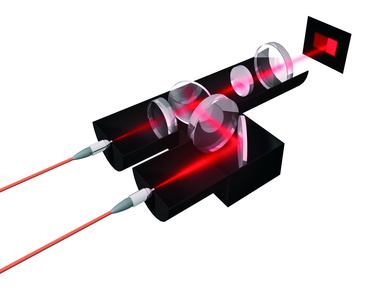
The system transforms the Gaussian intensity distribution of a single mode fiber into two top hats with different power density. The top hats are used for testing of optoelectronic devices. LightTrans was responsible for the whole development of the system from the first communication about the customer's need to the final delivery and installation at the customer's production facility.
Image Formation
Ray-tracing is an extremely powerful technique in the design and analysis of image forming systems. Wave effects are typically included by the MTF concept. However, wave-optical effects beyond the basic MTF approach can have serious impact on innovative image-forming systems. In particular the point spread function PSF becomes space variant. Moreover, high NA systems have also global and local effects on the polarization of light and therefore on the PSF. In general a local variation of the PSF has significant influence on the image formation. The degree of coherence is another parameter which can have enormous impact. In short, in micro- as well as macro-optics you may face an image formation problem, for which you need much more than ray-tracing.
LightTrans has developed techniques for various situations in which an advanced wave-optical analysis of image forming systems is required to get a full insight into the power and the limitations of the system. Using our electromagnetic simulation concept, we should be able to solve your analysis problem and to provide you all missing information about your image forming system you are looking for. And the best is: We will not only deliver the answers you demand for but we are able to provide you with a customized VirtualLab™ module to enable you to do such investigations yourselves in future.
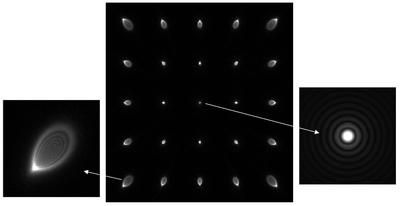
The PSF describes the image formation of object points. Aberrations and diffraction effects influence the result. We calculate the local variance of PSFs without any approximation but by propagating a grid of coherent or incoherent object point sources through the optical system. This way you get a fast and safe wave-optical overview about your image formation problem.
Focusing and Collimation
The complementary optical functions focusing and collimation are directly or indirectly involved in almost any optical system. It is well known that ray tracing is not suitable for investigating focal regions. That makes wave-optical techniques important for the analysis and design of focusing systems. A proper definition of light sources is a prerequisite for the analysis and design of high quality systems for collimation. Electromagnetically based light source models give maximum flexibility and accuracy to investigate collimating systems. In particular in high NA focusing and collimating systems, the z-component of the fields must be taken into account. Our electromagnetic field modeling provides this information. Moreover, electromagnetic modeling allows the investigation of focusing and collimation systems for partial coherent light sources and ultra short pulsed laser beams. LightTrans' optical engineering team will help you in all situations in which you need a more elaborate investigation or design of your focusing or collimation system.
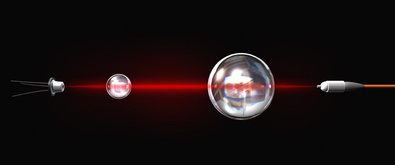
Coupling of laser light, here from a diode laser, into a fiber is of concern in various applications. In order to investigate the coupling efficiency one needs complete information about the electromagnetic field in the focal region. This is a typical task for which our electromagnetic modeling approach is ideal to deliver you all the information you need.
Refractive and Diffractive Beam Shaping
The transformation of the Gaussian profile of a coherent laser beam into other profiles like lines, crosses, circular or rectangular top hats and ring type distributions, leads to the design of beam shaping systems. LightTrans has introduced several advanced design techniques to solve a great variety of beam shaping tasks. Our beam shaper modules may be realized by employing refractive or diffractive shaping components. For each application it is critical to consider the pros and cons of both solutions, because they possess different characteristics like sensitivity to variations of the profile and wavelength of the incident beam, and of course to fabrication tolerances. The incident laser beam and/or the transformed beam are allowed to possess divergence angles up to 30° and more. With this feature, beam shaping of diode lasers is possible.
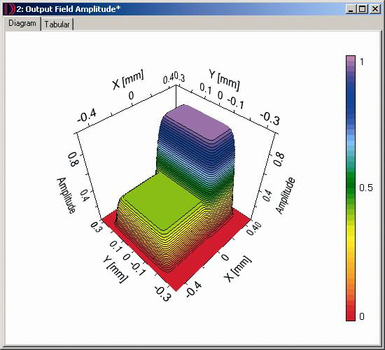
Example of the result of a beam shaping system which generates two top hat distributions. It results from the beam shaping system shown on the first Optical Engineering page.
Diffractive Beam Splitting
The identical replication of beams by use of diffractive beam splitters has various applications such as laser materials processing, metrology, medicine and sensoring to mention some of them. Conventionally, diffractive beam splitters are realized by laterally periodic structures that are gratings. In this case the replicated beams, which are represented by signal orders of the splitter, can only be positioned on an equidistant grid in the angular spectrum. LightTrans has introduced the diffractive MultipleBeamDeflector™ technique which enables an arbitrary positioning of signal orders, without being restricted to any grid. Moreover, the directions may be paraxial or non-paraxial. Our method should solve all the multiple beam splitting and deflection problems you require.
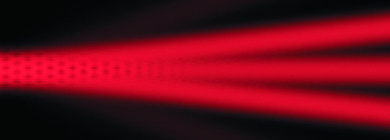
Diffractive beam splitters allow the identical replication of any type of monochromatic beam. The resulting beams travel in predefined directions. A subsequent collimation results in parallel beams with a specific equidistant distance between each other. Besides the desired beams a diffractive beam splitter produces always higher orders. Efficiencies of about 80-90% are realistic but depend on the specific application.
Shaping Light by Diffusing
We speak about diffusers if the radiation from a source is distributed in a more random-like manner to obtain the desired intensity pattern in the target region. This light transformation concept is adapted from holography. LightTrans designs diffusers with deterministic scattering behavior. LightTrans Deterministic Diffuser™ is designed by diffractive optics techniques often combined with standard lens design methods. Deterministic Diffuser™ is well suited for all partially coherent sources like LED and excimer lasers. But also for coherent laser sources they often allow the generation of shaped and homogenized light fields as long as the resulting speckle pattern is not resolved by the detector. Deterministic Diffuser™ technology is a powerful solution to technical and commercial illumination tasks, light pattern generation, and storage and display of information.
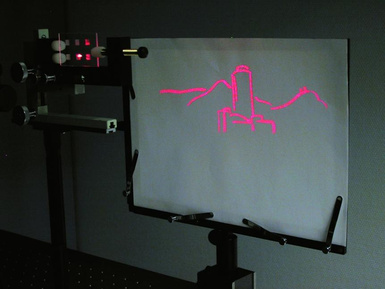
The setup demonstrates how the utilization of sophisticated non-paraxial diffuser design techniques allows one to obtain an amazingly large light pattern – here as example the 'skyline' of Jena – at a short distance behind a simple device consisting of a diode laser and a diffusing component.
Customized Holographic Screens for HUD Applications
LightTrans offers optical engineering and prototyping of foils with customized scattering properties
Screens for head-up-displays (HUD) diffuse light emitted by a projector unit towards an observer with a high efficiency. At the same time ambient parasitic light dazzling the observer should be avoided. Therefore the screen requires artificial scattering properties for the homogeneous and efficient illumination of the eye-box. Further the screens should be highly transparent and provide a good color rendering, enabling a high quality see-through vision.
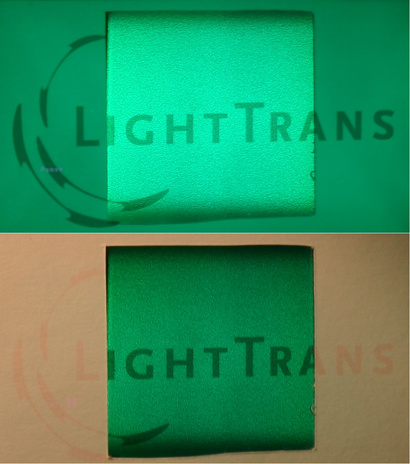
Upper Figure: Light diffusion of the holographic foil (positioned in the center) into the eye-box. For illustration of the efficiency, in the outer regions of the screen a Lambertian scatterer (white paper) is placed. The luminescence is clearly improved. Lower Figure: Same setup as shown in the upper figure, but with additional ambient parasitic light. The image contrast and color rendering of the Lambertian scatterer is significantly reduced, whereas the contrast provided by the holographic foil remains the same.
Thin holographic screens can fulfill all of these requirements. The fabrication consists of two steps. First, several surface scatterers (computer generated holograms) are designed and fabricated for different wavelengths. In a second step, all of these surface scatterers can be copied into a single holographic foil.
Advantages of the volume hologram technology for HUD screens:
- High scattering efficiency enabling an improved luminescence
- Customized eye-box illumination
- High vision-through transparency
- Applicable in monochromatic as well as RGB systems
- Insensitive to parasitic ambient light
- Stitching technology enables the unlimited scaling of the screen size
- Temperature stability up to 100°C
- Potential for easy and keen mass-fabrication
- Thin foil can be added easily on windshields and to existing systems
Download Virtual Lab Free Trial Version
Please contact sales for additional purchase options.
Contact Key Photonics about this Product
Send email | Call +44(0)1273 385460 | Use the contact form

